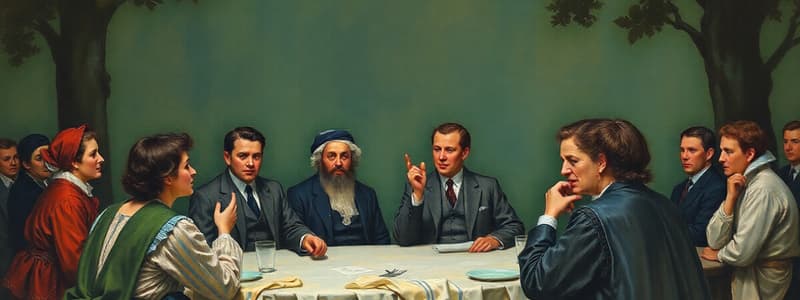Podcast
Questions and Answers
In what situation would Autocratic leadership be most appropriate?
In what situation would Autocratic leadership be most appropriate?
- When the team require empowerment and creative freedom within the workplace.
- When there is sufficient time to collect feedback from the team members.
- When the business needs quick decisions. (correct)
- When decisions impact various stakeholders, including local communities.
How is a participative approach to decision-making viewed by Democratic leaders?
How is a participative approach to decision-making viewed by Democratic leaders?
- It is permitted, as long as it does not interfere with the leader's final decision.
- It is seen as a sign of weakness, so it needs to be avoided.
- It is favored, as it increases consultation and overall agreement on various issues. (correct)
- It is avoided, as quick decisions are more important.
Which leadership style is most aligned with Herzberg's theory of motivation, which emphasizes employee involvement and recognition?
Which leadership style is most aligned with Herzberg's theory of motivation, which emphasizes employee involvement and recognition?
- Transactional
- Democratic (correct)
- Laissez-faire
- Autocratic
A school head is retiring in the coming summer and as a result lets things start to slip. In terms of leadership and management, which of the following best describes this?
A school head is retiring in the coming summer and as a result lets things start to slip. In terms of leadership and management, which of the following best describes this?
What risk does an organization face if it adopts a Laissez-faire leadership style?
What risk does an organization face if it adopts a Laissez-faire leadership style?
A democratic leader prioritizes employee involvement and delegation. Which of the following scenarios best exemplifies this leadership style?
A democratic leader prioritizes employee involvement and delegation. Which of the following scenarios best exemplifies this leadership style?
According to Herzberg's theory, what is the likely impact of a democratic leadership style on employee motivation?
According to Herzberg's theory, what is the likely impact of a democratic leadership style on employee motivation?
What is a potential drawback of the consultation-based decision-making process that is a key part of democratic leadership?
What is a potential drawback of the consultation-based decision-making process that is a key part of democratic leadership?
In what situation might a democratic leadership style be least effective?
In what situation might a democratic leadership style be least effective?
A company is considering a shift towards a more democratic leadership style. Which action would best support this transition?
A company is considering a shift towards a more democratic leadership style. Which action would best support this transition?
How does an autocratic leader's decision-making process typically impact employee morale and productivity?
How does an autocratic leader's decision-making process typically impact employee morale and productivity?
Which leadership style most closely aligns with Maslow's hierarchy of needs by focusing on employees' social needs and wellbeing?
Which leadership style most closely aligns with Maslow's hierarchy of needs by focusing on employees' social needs and wellbeing?
In what primary way does a leader's role differ from that of a manager, according to the information provided?
In what primary way does a leader's role differ from that of a manager, according to the information provided?
A company is undergoing a major strategic shift that requires quick decision-making and minimal consultation to ensure effective implementation. Which leadership style would be most suitable?
A company is undergoing a major strategic shift that requires quick decision-making and minimal consultation to ensure effective implementation. Which leadership style would be most suitable?
How might a paternalistic leader's approach to decision-making affect productivity, and why?
How might a paternalistic leader's approach to decision-making affect productivity, and why?
Flashcards
Management
Management
Organizes and coordinates resources within a company.
Leadership
Leadership
Sets goals and inspires others to achieve them.
Autocratic Leader
Autocratic Leader
A style of leadership where the leader makes decisions independently.
Top-down Communication
Top-down Communication
Signup and view all the flashcards
Paternalistic Leader
Paternalistic Leader
Signup and view all the flashcards
Democratic Leader
Democratic Leader
Signup and view all the flashcards
Consultation in Leadership
Consultation in Leadership
Signup and view all the flashcards
Delegation
Delegation
Signup and view all the flashcards
Employee Commitment
Employee Commitment
Signup and view all the flashcards
Consultation Time
Consultation Time
Signup and view all the flashcards
Autocratic Leadership
Autocratic Leadership
Signup and view all the flashcards
Democratic Leadership
Democratic Leadership
Signup and view all the flashcards
Democratic Leadership & Motivation
Democratic Leadership & Motivation
Signup and view all the flashcards
Laissez-faire Leadership
Laissez-faire Leadership
Signup and view all the flashcards
Comparing Democratic & Laissez-faire
Comparing Democratic & Laissez-faire
Signup and view all the flashcards
Study Notes
- The democratic leader encourages participation in decision making through consultation
- This leader acts on the majority opinion
- Democratic leaders also favor delegation, passing decision-making authority down the hierarchy
- This leadership style corresponds with Herzberg's theory on motivation
- Employees are more likely to be committed to decisions made within the business under a democratic leader
- Consultation-based decisions can take a long time, meaning the business is slower to respond to changes in customer needs
Studying That Suits You
Use AI to generate personalized quizzes and flashcards to suit your learning preferences.




